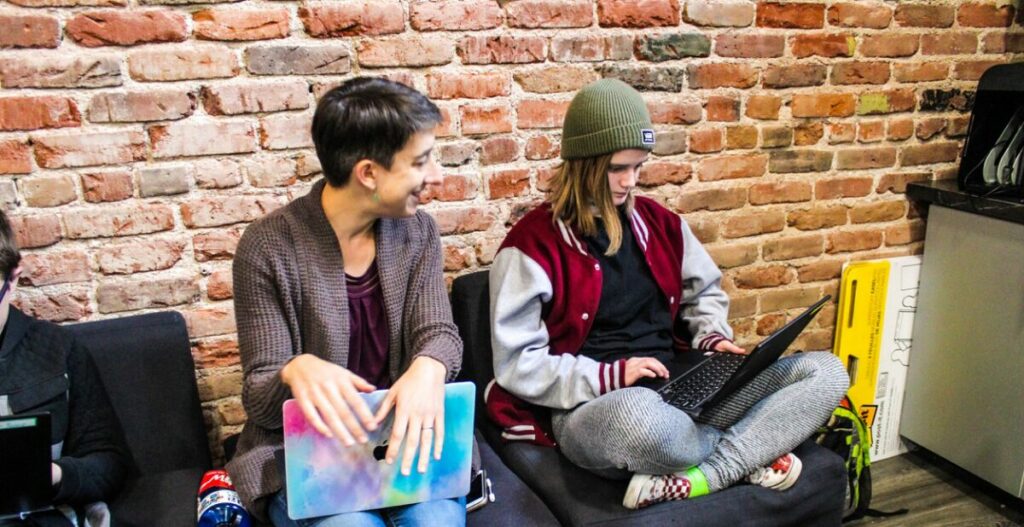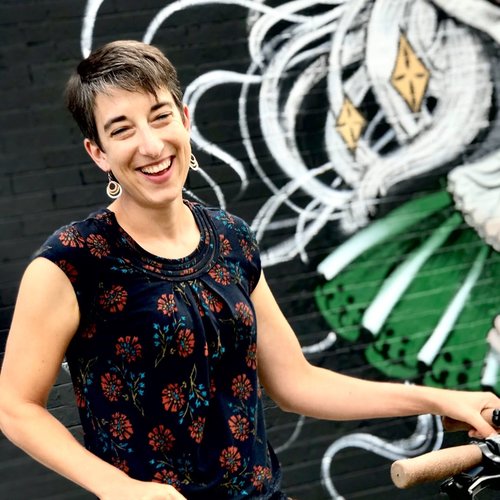The one thing I can say for certain is that true learner-centered education is messy, loud, complicated, magical, and it’s what we are obligated to provide for students…
Carissa Solomon, Educator, Embark Education
Imagine walking down a hallway and into a conventional classroom where a language arts lesson is in progress. The room is full of students at desks patiently listening to their teacher and raising their hands before speaking. On this particular day, many of the students participate in a lively literary discussion before submitting their reflective assignments that examine the relationship between two sisters in Alice Walker’s “Everyday Use.” The scene is familiar and predictable.
Leave that room and wander across the hall, carefully stepping around a group of students on the floor sketching family trees, and into a less familiar language arts lesson. The classroom door is flung wide open, and you realize the students in the hall originated from within. The scene inside feels like organized chaos: students are working on laptops, reading, leading small discussions, and writing haikus on the whiteboard. You’re so intrigued by the buzz of activity, it takes a moment to notice the teacher sitting in the back corner.
Which of these environments is most conducive to learning?
During my ten years of teaching in conventional schools, I frequently saw this type of contrast in how teachers handled their classrooms. Although both groups of students in the scenario above were learning about the literary element of character development, the two approaches were dramatically different.
In the first approach, students were following a learning pathway designed by the teacher. In the second approach, students were empowered to design their own learning pathways. What appeared chaotic from the outside was actually the magic and possibilities that unfold when schools embrace a more learner-centered approach.
Something’s Gotta Give
I was first introduced to a more learner-centered approach about four years ago, and it awakened me as a teacher. Step by step, I transformed my own classroom and saw firsthand that when students are given a broader scope in which to work, they become more invested in their learning.
Despite these positive changes, something still felt off. Learning in my classroom had become more differentiated, but it was still largely directed by external constraints.
I realized all I was doing was trying to game the system. I could only help students design their learning paths as long as they fit within the confines of the state’s academic standards, the daily learning target required by my school administration, the bell schedule, and our pre-set grading periods.
Once again, I questioned my approach. Why were static standards and policies at the center of the system, rather than student curiosity? Disheartened, I considered leaving education altogether. But, then I came across a unique job posting. An education non-profit was launching a new school concept in which the primary “role of the adults [was] to cultivate an environment where deep learning and exploration [could] occur.” I applied immediately.
A Fresh Start at Embark Education
In the summer of 2019, I began the next phase of my learner-centered journey as a founding team member at Embark Education—a Denver-based micro-school where two teachers serve 16 students, ages 12-14. I was excited to join Embark because of its small size, commitment to a learner-centered model, and the opportunity to create and grow a truly unique education experience for young people.
Our first year was rewarding, challenging, and full of many lessons. The most memorable lesson for me was designing a learner-centered model for teaching social studies and language arts. I discovered that each subject area required a different way of thinking, planning, and organizing.
With nine years of experience teaching social studies, I decided to design my approach based on those previous, more conventional, experiences. Conversely, my more limited experience teaching language arts allowed me to design a more novel, imaginative approach. I was unaware, then, of how difficult it would be to integrate conventional learning elements into a learner-centered environment and find success.
Conventional and Learner-Centered Thinking Don’t Mix
With social studies, my experience adapting an “original” approach rooted in conventional thinking and prior experiences fell flat. In the past, I had unknowingly removed student’s unique abilities and interests from the equation despite my attempts to create dynamic classroom environments, make history relevant to what’s currently happening in the world, and highlight diverse perspectives.
However well-intentioned, the trouble with this approach was that all ideas originated with me. I was creating. I was assigning. I was highlighting.
As I structured the social studies curriculum at Embark, I relied too heavily on this teacher-centered perspective. Independent of student input, I selected the content, timeframe, and end product of learning.
During the fall semester, students dutifully worked to understand the Bill of Rights in light of current government policy, but their discussions felt forced. Students weren’t truly expressing their views. Rather, they were reciting the ideas they thought I wanted to hear. I was still standing in the way of my students’ learning.
I altered my approach for the spring semester. Placing aside my prior experience, I introduced students to a frame of study without first identifying the specific content, academic skills, or final product. I began with an overarching question, “What have been the greatest triumphs in human history?”
Students jumped at this open-ended challenge—looking into topics as wide-ranging as renewable energy sources and feminism during the Romantic era. Some even renewed their interest in our work on the First Amendment’s freedom of speech clause from the fall.
Once students were engaged in their own explorations, the more conventional work of academic skills and content unrolled naturally. For example, when students felt overwhelmed by the amount of information available on the internet, they asked me how to improve their research skills. Or, one student’s work started with an initial interest in space travel, which led to a deep investigation of communist theory—a topic that would likely have shut him down had I dictated it from the beginning. The learning was meaningful and deep because it originated from student-driven inquiry.
The Successes of Starting from a Learner-Centered Frame
A learner-centered approach came more naturally in language arts. I began with the assumption that students were more receptive when given the autonomy to chart their own course. In the past, I witnessed that students, even those who loved reading and writing, were disengaged and unmotivated when the teacher created the assignments.
Beginning from scratch at Embark, I sketched a content frame that enabled students to be responsible for directing their own paths, while I served as a guide. Through the topic of character development—now you see why I asked you to “imagine” this scenario at the outset—students were inspired to lead insightful discussions, write original and hilarious narratives, and question the traits that make a good leader in ways that were relevant to their own experiences and provoked new insights.
Through this frame, I found that students were on separate but connected paths, genuinely excited about their work, interested in learning from their peers, and engaged in richer discussions that were informed by a diversity of fresh evidence, ideas, and perspectives.
As their educator, my role was to guide students’ inquiry toward logical intersections with relevant skills and content within the larger language arts framework. Over the course of the year, each student worked to improve their skills of written communication, research, discussion, and reading critically within an inquiry context they designed.
As an Educator, I’m Definitely Still Needed
Reflecting on my second semester, I was most successful when I was able to provide students with enough space, grace, and guidance to successfully chart their own course. This doesn’t mean that I, as an educator, am no longer needed. Instead, it represents a shift in perspective.
Rather than being the sage on the stage, learner-centered educators strive to adopt the role of content framer, skill coach, and inquiry advisor. This nebulous role can actually be more challenging as it requires teachers to relinquish control over the precise direction of learning.
It’s one kind of challenge to craft units, gather materials, and prepare lessons that fulfill required state standards each year. It’s a challenge of a different magnitude to hold those standards as a backdrop while supporting students to follow the course of their own intellectual curiosity. It requires flexibility, humility, and a desire to learn alongside students.
The amazing and challenging thing about this practice is that it is, by definition, individualized for both students and educators. I can share my experiences and strategies, but that doesn’t mean they will work exactly the same for another educator. Happily, this means that practitioners of many different pedagogical traditions can adapt, rather than abandon, their current methods to achieve a more learner-centered approach.
Students are truly at the heart of a learner-centered environment, so each conversation, lesson, classroom, and/or school will (and should) look unique. The one thing I can say for certain is that true learner-centered education is messy, loud, complicated, magical, and it’s what we are obligated to provide for students if they are to be truly prepared to meet the skill demands of 2022 and beyond.

